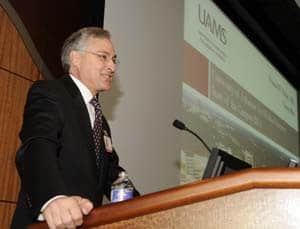Rahn Reports Successful 2010 for UAMS
| Jan. 13, 2011 | Record enrollment, growing patient volume and a strong complement of grant-supported research translated to solid financial footing for the University of Arkansas for Medical Sciences (UAMS), reported Chancellor Dan Rahn, M.D., in his Jan. 13 State of the Campus address. The chancellor reported a positive financial performance in clinical operations, which is responsible for 70 percent of the institution’s revenue. At the same time, the five colleges and its graduate school had the largest total enrollment (2,836 students) in UAMS history. Buoyed by one of the largest grants ever received by an Arkansas institution – a $102 million federal stimulus grant to improve broadband connection in Arkansas – UAMS continued to see increased federal research funding. UAMS Medical Center has moved from a loss to a financial gain of $5.7 million – a $24 million shift, the chancellor said. The institution was aided by an ongoing, campuswide performance review that resulted in $12 million in savings. “Economically speaking, we are doing well,” Rahn said, adding that continued success would require “sustained, focused effort.” He praised employees for helping lead UAMS through challenging financial times while still focusing on the UAMS mission “to engage in activities that result in better health now and in the future.” Projected revenue for fiscal year 2011, which ends June 30, is $1.2 billion. Seventy percent of that total comes from patient care; 15 percent from research grants and contracts; 9 percent from state appropriations; 4 percent from gifts and other sources; and 2 percent from tuition, Rahn said. The chancellor noted that the largest revenue source has traditionally been UAMS clinical programs. That revenue is needed, he said, to help fuel the research and academic activities in support of the UAMS mission. Since assuming his post in November 2009, in the middle of the 2010 fiscal year, it was Rahn’s first State of the Campus report at UAMS. Among the highlights:
See other UAMS highlights of 2010 in this year in review. Eyeing the road ahead, Rahn said that regardless of what changes are made by federal health care reform, many trends in health care were clear. Those trends he cited include a growing aging population, health care work force shortages, increased use of distance education and telehealth, bundled payments for care, increased public reporting about quality of care, less public funding and an alignment of research and clinical operations. “Most of the threats, weaknesses and opportunities are due to things we have the ability to change,” Rahn said. In its position as the state’s only academic health center, Rahn said, “we have a unique capacity and responsibility to lead health and health care improvement in Arkansas because of our intersection of education, research and clinical programs and our statewide reach. “We must focus on the state as our platform in everything we do on our campus and throughout the state.” Strategic goals set by UAMS as part of a strategic vision for 2020 included continued improvement of clinical programs – both in quality and financially; promoting multi-disciplinary research programs; a broader footprint for primary care programs across the state; and expansion of translational – “bench to bedside” – research. “If we figure our strategy, tactics and goals, we advance the mission of UAMS,” Rahn said. He challenged employees to do what is necessary to help UAMS achieve its goals. “Knowing the right thing to do is rarely difficult,” he said. “Doing the right thing is the key.” |
